
|
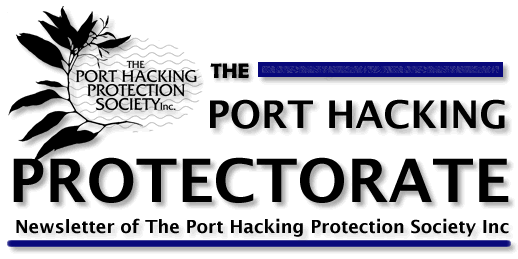 |
July 1999 |
|
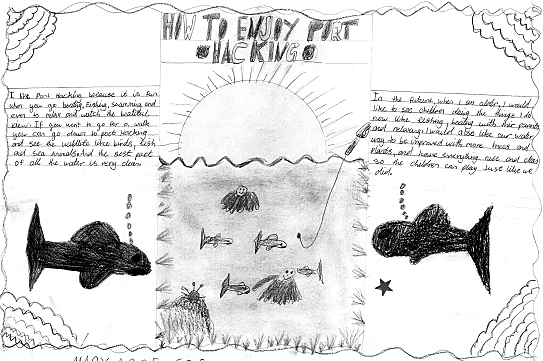 |
Sutherland Shire Council
A review of promises and action
Last November we published a policy update from Councillors. We have summarised these policy statements, along with (an indication) of outcomes to the end of June.
Liberal Councillors - Schreiber, Rodden, Simpson, Redmond
The commitments of the Liberal Councillors were to the following actions.
Maintenance dredging - Implemented (with potential for improved channel design in the future). Future funding dependent on satisfaction of the NSW government requirements of SEPP 35, previously satisfied by the Memorandum of Understanding, not implemented. No action to protect environmental or other recreational interest as required by the MOU and SEPP 35.
Implementation of the Port Hacking Plan of Management was reaffirmed - This Plan has not been successfully implemented No action on waterway management, environment protection or non-boating interests.
Implementation of a Riverkeeper - Announced Arrangements being negotiated with Waterways Authority. Implementation has not yet occured. Focus is on boating management.
Water quality devices to protect Water quality - The number of water quality devices has been increased. Over-reliance on "end of pipe" solutions, instead of "at source" controls.
Better management of construction sediment - Many problems still exist. Council has recently employed an education officer and has been more active in enforcement. It is expected that compliance will improve as a result.
More effective waterfront planning controls - Waterfront planning controls have not been effective in protecting the natural conditions of the foreshores. There is no indication of commitment to meet this objective.
Investigation and rectification of Sewage contamination in conjunction with Sydney Water - Works are now underway by Sydney Water. Improvement is expected.
SSC Labor Councillors - Emerson, Smith, Blight
The minority bloc of Labor Councillors indicated the following priorities.
The failure of SSC to implement the Memorandum of Understanding on Navigation Dredging - Unable to secure implementation of these programs.
Concern about the failure of SSC to implement the Port Hacking Plan of Management - As above.
Overdevelopment and the failure of foreshore controls - As above
SSC Independent - Hurst
Support for the Port Hacking Plan of Management and the Memorandum of Understanding - Unable to secure implementation of these programs.
A summary
The present Council has not been succesful in management of the estuary. In providing 'end of pipe' devices to trap trash, it has made some progress, but in controlling the problems "at source" it has been less effective. This Council has often been 'green' in its rhetoric, when the decisions are outside its control. But Council itself has been far from effective in its own actions, failing to work effectively to protect and enhance Port Hacking, often letting short term interests override long term community needs. The result will be a vicious cycle of increasing problems, and increasing expenditure on band aid remedies.
Some readers will see this harsh judgment as reflecting a bias against the Liberal side of politics. This is untrue. We have been happy to publicly applaud the long term efforts of Malcolm Kerr, and indeed Liberal councillors in the previous Council. Our policy is to report honestly what we see happening. What we have seen with this council has been a 'develop at any cost' mentality in the actions that have been taken, contrary to both its rhetoric, and contrary to the environmental focus and fairness that the community clearly wants.
PHPS Inc. membership spans the political spectrum. We have no party political preference. But we do have a strong preference for a Council that will reflect what the community wants, and which takes full account of the need to protect the opportunities for the next generation. We look forward to the next Sutherland Shire Council being a positive force in the protection of Port Hacking |
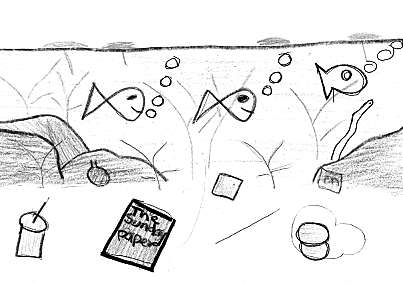 |
Editorial
How many plans does it take?
If plans would protect the environment and opportunities for low key users, Port Hacking would be well managed on a sustainable basis. Unfortunately, plans without political commitment are a waste of paper. A number of plans exist. Most reflect careful balancing of different interests, whilst protecting the ecology of Port Hacking for future generations. Each deals with some aspect of the Port which is important to its sustainable long term use. But mostly they are public relations window dressing.
Plan 1 - Sutherland Shire Council Port Hacking Plan of Management
This plan proposes strategies for protection of biodiversity, improved waterway access and public facilities, and a host of other initiatives. The Port Hacking Planning and Advisory Committee (now disbanded, with a Panel to be appointed) was charged with its implementation. The Planning and Advisory Committee has pursued only two elements in that plan in the term of this Council. The first was to prevent through-the-hull sewage discharge, and the second was to appoint a Riverkeeper. Neither has been implemented to date! The existing pump-out facilities are not being used, and the much-heralded Riverkeeper program remains unimplemented.
Plan 2 - Memorandum of Understanding on Navigation Dredging
The MOU was required to provide a balance between environmental and recreational boating requirements, within the NSW government's policies on sustainability of biodiversity. A milestone in cooperation, the MOU was the basis for securing a commitment for two rounds of dredging, with the expectation of ongoing funding with the successful implementation of this agreement. Where is this key plan now? A review by the Hacking River Catchment Management Committee has highlighted that virtually none of the environment management initiatives agreed between representatives of boating, environment, government and resident interests has been implemented. Instead of a framework for cooperation to achieve fair and sustainable use, the MOU has become a further indicator of just how little commitment there is to the rhetoric of fairness and environment protection.
Plan 3 - Boating Plan of Management
The Minister's announcements indicated that this plan was to provide effective protection of the ecology of the Port from boating impact, particularly through the hull sewage discharge. It would also provide effective control over jetski noise, and protection for swimmers and users of non-powered vessels such as kayaks. Where is this plan at? Some in the boating community have expressed strong objections to any environmental protection. Some have, for example, spoken of through-the-hull sewage discharge into the Port as a right (notwithstanding the illegality of the practice); others consider it unfair to propose controls to prevent noise from jetskis affecting foreshore residents or users. Others consider it unfair to allow kayaks to access environmentally sensitive areas such as the Basin whilst restricting power boats in the same area. Waterways have implemented a speed reduction for half of Hordern's Beach at Bundeena, but intend to increase moorings in sensitive areas. Nothing has yet been proposed to control through-the-hull sewage discharge, or the protection of the Basin or the remaining Posidonia beds, though one of the proposed additional moorings is to be 'seagrass friendly'. Nothing has as yet been proposed to create more effective management of the noise and safety hazards from the growing number of jetskis. It remains to be seen whether Waterways will implement an effective strategy to protect the majority of users, and the biodiversity resource, of the Port Plan 4 - "Enjoyment for Today, Protection for Tomorrow"
This draft plan was prepared to give effect to the preceding two. It was prepared by representatives nominated by the Catchment Management Committee (2), the Port Hacking Planning and Advisory Committee (2) and the Waterway Users Group (2).
Wider public consultation on the draft was deferred at the direction of the Chair of the Advisory Committee (Ald. Hodson) because of concerns about the reaction from the small number of boating users who object to any environmental protection within Port Hacking. Plan 5 - Fisheries habitat plans and policies
Fisheries has increased the protection for shellfish on the Southern side of the port. They have not, however, increased the policing resource required to give effect to these rules. It remains to be seen whether Fisheries will take a more systematic view of the biodiversity of the Port and implement protection for the Basin and for the sensitive seagrass habitats.
Plan 6 - Sutherland Shire Council Foreshore Development Code
This Code has an objective of maintaining the natural appearance of the foreshores. Based on a visual survey of the Port, and the reports of residents and users of the Port, this Code is more honoured in the breach than the observance. It would seem to be a regular occurrence for houses, walls, boatsheds and other facilities to be built below the setback lines, and in direct contradiction to the Code. |
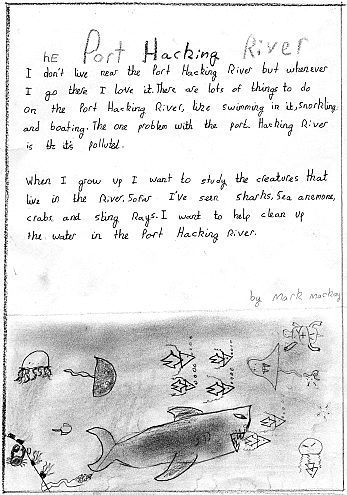 |
These are not the only plans and policies that are not given effect. Sutherland Shire Council subscribes to the international Agenda 21, which requires a paramount commitment to sustainability and equity in the management of natural resources. This is not reflected in their approach to the Port. Waterways Authority are meant to control noise nuisance under Reg 5 of the Noise from Vessels legislation. Reports to PHPS (Inc.) indicate that they consistently fail to do so in Port Hacking. Illegal moorings should be removed under Waterways' policies, but they are not. Many other examples could be identified which tell the same story - lots of plans and paper controls, but very little effective action.
It only takes commitment
There is only one ingredient for effective management which is lacking: commitment. Plans require constant updating and refinement to meet changing circumstances, but there is little reason to put in the effort unless someone is going to allocate the resources and the effort to have these plans work. The natural resources of Port Hacking are limited. The demands on them are not, and these demands are growing. The signals of the stresses are there:
-
deterioration in water quality, shown by the high levels of contamination in shellfish in the Western end of the Port, and in reports of high level contamination in the Eastern bays;
-
the decline in the native tree and natural vegetation cover on most of the Northern foreshores and increasingly around Bundeena and Maianbar;
-
the reported long term reduction in the populations of crabs within the Port;
-
photographic evidence of damage to seagrasses from anchoring;
-
observation of the growing numbers of users, and the extent of harvesting of the shoreline.
-
increased user conflicts and policing issues.
The result of such pressures will be degradation, and the loss of the opportunities for the types of recreation that require clean water, peaceful conditions, and a healthy ecology, unless the public relations of government is matched by a commitment to act. This commitment, in turn, requires that the community make its concern for the Port clear and unambiguous to those who represent us. The upcoming Council elections are an opportunity to send a strong signal to our local representatives, that we actually do want more than rhetoric in the protection of our much loved Port Hacking. Other authorities, like the Waterways Authority, need to be reminded of what all of survey evidence shows - that whilst we love to use Port Hacking, we also value it for itself. It is a resource that we want to be able to hand on to our children in at least as healthy and beautiful state as we found it. Only through action, not words, will this be possible.
Stop Press
Progress on Audit of Plan Of Management
In February the Port Hacking Planning and Advisory Committee reviewed the audit of the Port Hacking Plan of Management (POM). We have previously reported the results of that review. It was resolved "That at the next meeting of the Port Hacking Planning and Advisory Committee, a further review of the outcome of the audit be discussed." That step has not yet taken place.
It was also resolved "That the Director of Environmental Services provide a report to the Port Hacking Management Panel on the costs and resourcing implications of the completion of a visual survey of the foreshores of the Port Hacking River" using funds that were budgeted but not spent on the Riverkeeper program.
The visual survey of Port Hacking's foreshore is one of the few benchmarks available to Council. It would show how the visual qualities of the foreshore (notably the extent of natural vegetation) have changed over the past few years. What's in a name?
The Port Hacking Planning and Advisory Committee has been dissolved. It is to be replaced by a Port Hacking Management Panel, with 18 members comprising, two Councillors, two Council staff, six representatives of various authorities concerned with the Port, and eight commercial, environment and community representatives.
Not enough pollution |
 |
Shortly after this photo was taken, Sutherland Shire Council removed the gross pollutant interceptor claiming the amount of debris it intercepted did not justify the cost of its continuance! Given that residents had complained loudly that adjacent works would increase pollution into the Port, it is not surprising that they are unimpressed. The untrapped debris now sails directly into the Port.
How many moorings in Port Hacking?
How many moorings should there be in Port Hacking? The question was asked of Waterways by the Sutherland Environment Centre, whether there was any problem with the various bays of the Port becoming effectively boat parking facilities due to the ever increasing number of moorings being 'dropped'. Waterways indicated that the visual aspect was not a matter of concern for them, and that there is no limit proposed for moorings within Port Hacking. |
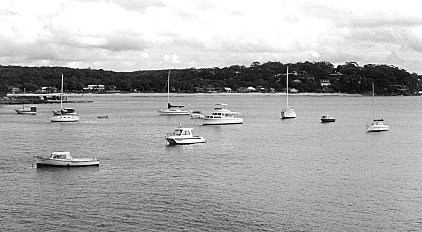
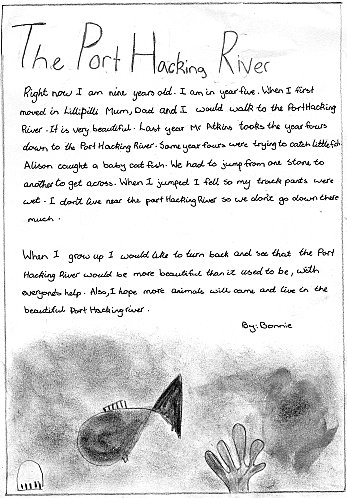 |
What is the Foreshore Development Code?
The Objectives
7.1 "minimum disturbance to the natural landscape
7.2 "integrate development into the site and natural surroundings"
7.4 "Encourage landscaping to soften the appearance of development when viewed from adjoining properties and the waterways" Foreshore Development Development Control Plan Edition 6,1997
These themes are repeated in various ways through the Plan. There is repeated reference to buildings which blend with the natural surroundings, and the prevention of adverse impacts on views from other houses and the water.
The foreshore building line is one of the means to these ends. Its objectives are:
-
preservation and enhancement of the natural features and vegetation...
-
restoration of the land below the foreshore building line .. to a natural state, with a minimum intrusion of manmade structures ...
-
a significant reduction in the number of structures below the foreshore building line.
It is expected that if a new structure is to be put In place of another, the net effect will be to reduce the total structures below the line. The plan also indicates that exceptions are to be allowed only under exceptional circumstances.
But what is the real effect of these controls?
But the reality is somewhat different to the rule. At the recent NSW government enquiry on development in Sutherland Shire, it was highlighted that Sutherland Shire Council has something of a record in granting exceptions from its development controls. Nowhere is this more obvious than on the foreshores.
A recent example in Yowie Bay serves to illustrate the point. Residents were surprised at a building application with about 60% of the proposed building below the foreshore building line. The home being extended had evolved from a boatshed. There was no intention to use redevelopment to reduce the foreshore structures. What surprised local residents most was Council officers' argument that removal of the existing structures would leave an unvegetated scar on the waterfront. Of course, this will always be the case with any removal, until revegetation occurs. By this logic no waterfront structure could ever be removed! We, like the residents, await the final decision.
What would you expect from an effective Code?
If the Code were being implemented you would expect that the extent of structures below the foreshore line would be decreasing. You would expect better designed, less impactful structures to be replacing the mistakes of the past. You would expect that the natural look of the foreshores from the water would remain, and perhaps be enhanced by complementary landscaping. Now look around the Port. What is occurring? There is a myriad of examples of developments well below the foreshore line, and the incremental loss of natural vegetation on the foreshore. The code is clear, but the implementation falls a long way short of the code requirements.
Will we get the foreshores we deserve?
There is a difficult balance to be struck between the legitimate expectations of property owners to get the full enjoyment of their property, and the equally legitimate expectations of the community to have the common resource - views, water quality, biodiversity, recreational opportunities - protected. The key to balancing owners' interest and community interest, is effective education of owners and developers, and strong and effective foreshore development rules. It is asking a lot of individuals to impose on themselves a greater concern for neighbours and the environment than is required of them by the law, though there is a great number of such unsung heroes around the Port. It is not in the least unfair to ask that our local Council does create and enforce foreshore development codes that provide a solid basis for protecting the biodiversity and visual appeal which is part of our shared heritage.
Dolans Bay: Then and Now
by Ken Palmer, Dolan's Bay
Dolan's Bay is one of the bays where residents are saying "enough it enough" when it comes to the loss of natural condition. "Do we want all our bays to become boat parking areas?" is being asked more often as the number of moorings increases within the boundaries of the National Park, at Gunyah, Jibbon and in Dolan's Bay. To the question "Is it acceptable to lose the natural state of the shoreline?" the community has given a resounding 'no' in all surveys. Dolan's Bay and Yowie Bay residents have become more direct in pressing to protect the natural beauty of their areas, having seen the effects of not doing so. |
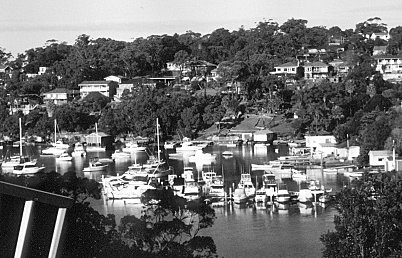 |
The news is not all bad - residents are having some effect on limiting overdevelopment, and there are some instances (such as one proposed in Dolan's Bay) where developers have sought to create more natural space and tree cover, by not developing sites to the maximum. But only with a full recognition of the natural beauty of our bays, a community willing to stand up to defend this beauty, and effective management can we be confident that the natural beauty we have the privilege to enjoy will still be available to our children and grandchildren.
We asked a long term resident of Dolan's Bay to reflect on the changes that have taken place. Memories are always prone to error and there is a human tendency to romanticise the past. I trust that some readers will correct the errors, and that most will understand the latter tendency.
Our memories are mainly concerned with Dolan's Bay and that area of the southside of Port Hacking extending westwards from the Deeban Spit to Costen's Point. My wife's father bought a weekender in Dolan's Bay in 1947 when that area still had vestiges of its "rural" background, vacant blocks by the score and patches of blackberries in season. "Oriel" was one of only four boats in the Bay. The present Dolan's Bay Marina was then Charley Alexander's Boatshed and Charley himself was the next door neighbour.
Part of our courtship was to row across to the Deeban Spit. But it was very different from the today's scraggy spit. We recall it as being two pronged - the eastern prong (in its scraggy state) - still exists. The western prong - separated from its mate by Cabbage Tree Creek - stretched over towards Shiprock Point, existed above high water and was well vegetated. Looking at the present configuration made us doubt our memories but when we referred to the Second Edition of the "Tourist Map of the Port Hacking District (undated), it seems to confirm our memories, as does the shape of the present sandflats in that vicinity. Perhaps the vegetated "island" off Maianbar is both a remnant and an indicator of the nature of this one grand prong of the Deeban Spit.
To us, Turriel Point (on the tourist map) was always Shiprock Point. To its west was the old red corrugated iron boatshed known as Simpson's and which we believed had once been owned by Charley Alexander. Today only remnants of its eastward sloping slipway can be seen.
Still evident through the 60's and 70's were the remains of the bridge and wharf extending from Maianbar across Cabbage Tree Creek onto the eastern prong of Deeban Spit - its actual landing, with bollards, half buried in the sand several metres "inland" from the water's edge.
Travelling westwards across the flats of the southern shore one encountered, on the flats between Fisherman's Bay and the main Channel, several deep holes and at least two small sand islands - delightful playing places at low tide for our young family.
West of the channel leading into Fisherman's Bay, the shellgrit dredge worked. For how long it had operated I don't know and I can't be sure when it ceased operations. Certainly the extreme softness and "lack of body" of the sand in those flats were attributed to its operations. For years afterwards an abandoned punt, presumably from this finished industry, was a rotting memorial.
On Red Jack's Point were the complete sandstone walls of a building whose history is unknown to me. In my experience it was always roofless but its sandstone construction and simple lines were very appealing. Further around the point was a weekender cottage - very suburban looking and now gone. On Costen's Point were a number of cottages - almost a village and including a tennis court, swimming pools, slipways and elaborate landings. the remains of some of these latter constructions still exist.
What more can I say of this small, beautiful section of the Port that was so central to our lives and those of our growing family in these years? Compared to today, it was undoubtedly quieter and cleaner. There were a lot of fish caught and we could scoop prawns in Dolan's Bay. Perhaps the fish are there today - I don't know. But certainly the Port is different. Superficially it still looks beautiful and a great playground for an ever-growing population. It provides superlative views for a growing number of houses. However the signs of a deteriorating environment are evident. Greater run-off pollution, water often dirty, increasing amounts of rubbish. What knowledge have we of deterioration of seagrasses and marine life?
Measured against its glories from the comparatively recent past the Port is at risk. We cannot afford to take its beauties for granted. |
 |
The concern about overdevelopment of Dolan's Bay is not only about the former Convent site. All of the foreshores, and the waterway itself, are under development pressure. The real question is not whether any single proposal is good or bad, it is whether the cumulative effects will create the type of place that the people who live there want.
Shire Watch
Independents for Sutherland Shire Council |
 |
A new group has emerged to contest the next Council elections. We asked Shire Watch for their polices for Port Hacking Election candidate Bob Spencer (above) provided us with this policy statement.
Four years ago, when this current Council came into power, there was in place an effective Port Hacking Planning and Advisory Committee (PHPAC), with a clear plan. There was a memorandum of understanding covering dredging and environment protection, and there was a clear Foreshore Protection Code. We have a myriad of examples of what has happened since then.
-
foreshore over-development, coupled with the abject failure of the Council to even put into effect sediment control on building sites, has had a marked impact on the foreshores and waterway. Sediment in the heads of bays is far worse than it was when they came into power, and there is no real plan to fix the problems
-
the Memorandum of Understanding on which basis the State government was prepared to fund navigation dredging, and which had the support of all interest groups has not been implemented, and has been allowed to lapse.
-
boating users, residents and environmentalists have all joined in the chorus saying that this council has failed to consult, and failed to deliver, on any waterway issue.
This Council has been good at publicity, but not good at actually doing anything for Port Hacking. The 'successes' that Council might claim are myths. The success of the last round of dredging in placing the sand offshore arose because of the good work of Fisheries and the Catchment Management Committee in pushing for a proper method of sand disposal, over the opposition of Council. Even the much publicised Riverkeeper, with community support, has been continually promised but still not delivered. The only outcome of this Council's policies has been to escalate conflict, by its divisive and non productive approach If this keeps up, we will hand on to our children a severely degraded estuary, not the treasure that we love, and which they ought to get to enjoy. |
What Shire Watch will do about it
-
Reinstate an effective Port Hacking Planning and Advisory Committee, with a clear brief to implement the Plan of Management.
-
Consult with boating and non-boating interests alike to revise that plan in a way that ensures that the Port is managed to maximise its value for all the different user groups, whilst protecting the ecology for the longer term.
-
Work closely with the Catchment Management Committee to agree environmental and recreational objectives for the Port, and to implement them in close cooperation with all the relevant government departments and local users of the Port. We will publish, and be held accountable for, these objectives.
-
Strengthen the foreshore development code so that everyone, residents and developers alike, can be clear about what is and is not allowed. We will publish our objectives, and be held accountable for the success of this code.
-
Renegotiate a Memorandum of Understanding with the key stakeholders and with the NSW government, to cover navigation dredging, waterway management, and foreshore management in a more integrated and effective manner than is occurring at the present. We will publish and report on our implementation objectives for this agreement
|
|
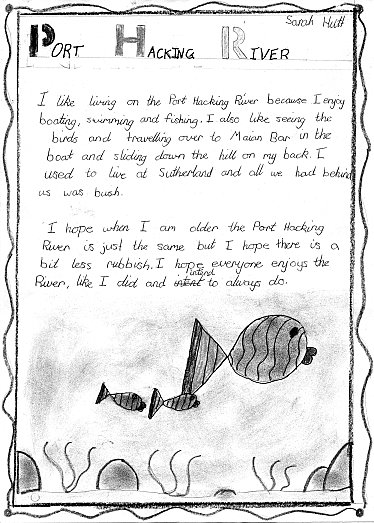 |
What Does the Community Want?
Melissa Gibbs, Hacking River Catchment Management Committee
The Hacking River Catchment Management Committee has recently reviewed research on community attitudes to the environment. The review feeds into the development of the Committee's work plan for the next few years.
What do Sutherland Shire residents think? (1998)
Environmental concerns loom large in the thinking of Sutherland residents. The surveys conducted for Sutherland Shire Council by the Hunter Valley Research Foundation (Ref) find that the environment figures in 6 out of the top 10 issues for residents surveyed.
The top three issues overall were: water pollution, waterways/beaches/wetlands, and air pollution. (Ref) Kerbing, guttering and pot holes do not make an appearance until the 25th ranking. These findings present Sutherland Shire Council with a major challenge, given the high proportion of budget allocation to road improvements, compared to environment protection/enhancement.
This is in line with State-wide trends. A survey of eleven other councils in southern Sydney reveals similar concerns for the environment, which rates right up there with planning and development issues, community safety, and concern for urban design and amenity. Makes you wonder why State elections are fought on the hoary old issues of law and order and cockroaches in hospitals! Attitudes across the State (1997)
NSW residents are now better informed about the processes affecting the environment. A recent EPA survey (Ref) has found that residents in NSW now do many things to make their home and work environmentally-friendly. The community is more concerned about the limits of natural resources and the detrimental effects that humans have on the delicate balance of nature. The EPA survey reports that water and air pollution are the two issues of highest priority for the NSW Government to address, with freshwater pollution (followed by beach/ocean pollution) and vehicle emissions (followed by industrial emissions) as the major focus of concern. There is a greater appreciation of the need to provide a healthy environment for a productive economy, rather than one at the expense of the other. There is also strong support for strengthening regulations on industry. Overpopulation is increasingly seen as a contributor to environmental problems, also in line with trends in southern Sydney.
The Sydney Coastal Zone (1996)
The Sydney Coastal Councils Group surveyed the community in September 1996 as part of the development of its coastal management strategy (Ref).
The survey identified 7 key coastal issues. The top five rankings across the survey area (in order of priority) were: water quality, conservation of natural heritage, sewage treatment and disposal, ecologically sustainable development (ESD) and development. The rankings across the Hacking varied to the overall rankings: ESD (1), sewage treatment and disposal (2), conservation of natural heritage (3), coastal dynamics (4), development (5).
The sample for this survey is small, so results are not as reliable as for other surveys discussed. However, what is noteworthy is the Hacking's ranking of ESD above 16 other coastal issues. Respondents see opportunities to promote ESD through its incorporation into local and state planning and management instruments - surely a challenge for local government, which is grappling with its legislative responsibility to "properly manage, protect, restore, enhance and conserve the environment in a manner which is consistent with the principles of ecologically sustainable development''(Ref) not to mention the State Government, which has so far totally overlooked ESD in its review of Part 3 of the Environmental Planning and Assessment Act, 1979.
Shire residents' attitudes to Port Hacking (1985)
Attitudes to Port Hacking have not shifted much in over a decade. A 1985 study of Shire residents to determine attitudes to Port Hacking (Ref) found strong support for the development of a policy or management plan to look at the future of the Port, what it has to offer and how it can best accommodate the needs of users.
The majority of respondents favoured controlled dredging in the major navigational channels, but within an environmental protection framework. Residents were aware that competing and conflicting waterways uses will be an increasing issue with the increasing population. They also wanted improved access to the water from the foreshores.
The survey does indicate understanding of, and appreciation for the complexity of the issues facing policy and decision makers. It is also interesting to note that residents have been calling for an integrated plan to manage the future of the Port since 1985 (and probably earlier), with no perceptible action in this regard. The Catchment Management Committee recently made representations to the Premier of NSW and other Ministers, seeking an integrated approach to decisions about the Hacking by the many agencies who have some part to play in its management. Foreshore Residents views (1997)
The Hacking River Catchment Management Committee (HRCMC) published the results of a survey of foreshore residents (Ref). The survey found that the ecological health of the estuary is the dominant concern of respondents, with residents of the southern shores showing significantly higher concern for the protection of the estuary's natural qualities. Residents were more concerned about visual impacts than with boating safety concerns and noise impacts. However a substantial proportion of respondents were also concerned about noise associated with small motorised craft such as jet skis, power boats and tinnies. Concern about visual amenity, including vegetation loss and the effects of housing construction is also high. This is followed by concerns about boating safety including adequate policing, navigability and safe boating practices.
Conclusions
Shire residents' concerns for the environment are in line with State and region-wide trends. The findings of the Shaping the Shire research present major challenges for Sutherland Shire Council in terms of budget and staffing allocation, and internal structure and management arrangements. What is certain is that Sutherland Shire Council is not alone - State and local governments must ensure they keep pace with community aspirations and ensure they are well placed to address community demands, particularly as the community becomes more aware of and concerned about the environment.
For the Catchment Management Committee, awareness of what the community wants for the Hacking is significant in determining the management priorities. That these attitudes consistently show that the community is above all concerned with protecting the natural character of Port Hacking, its ecological health, and the opportunities for low impact recreation. This is a positive sign for the future. References
Shaping the Shire - Community Priorities Revisited (Hunter Valley Research Foundation for Sutherland Shire Council, 1998)
Shaping the Shire - Community Priorities Revisited (Hunter Valley Research Foundation for Sutherland Shire Council, 1998)
Who Cares About the Environment In 1997? Environmental Knowledge, Attitudes, Skills and Behaviour in NSW (EPA, 1997)
Draft Sydney Regional Coastal Management Strategy (Sydney Coastal Councils Group Inc., 1998)
Local Government Act, 1993 as amended
A Study of Resident Attitudes to Port Hacking (Elliott & Shanahan for Sutherland Shire Council, 1985)
Foreshore Survey Report (Hacking River Catchment Management Committee, 1997) 1999 Presidents Report
This is an edited summary of the Annual Report of the President of the Port Hacking Protection Society, Mr John Atkins.
Why frustrating?
With Sutherland Shire in the midst of a building boom, we see constant evidence of poor control of sediment runoff from building sites, including sensitive waterfront sites. Residents in a number of the Northern bays are noting the negative effects of sediment inflow. The sediment that has choked Yowie Bay is an example of a broader problem. One has only to open your eyes to see that substantial areas of natural foreshore continue to be lost under waterfront structures.
Noise and danger from high powered craft continue to detract from the enjoyment of the Port for many residents and low impact users. But what is being done to correct these obvious problems?
A review of the Port Hacking Plan of Management has revealed a long list of actions which have not been addressed. Review of the Memorandum of Understanding has shown a similar pattern of grand promises but negligible action.
We have a long way to go in working out how to reverse environmental deterioration or to find an effective way of engaging in constructive debate about how to balance development and recreational usage with environmental protection. PHPS (Inc.) has continued to work through the Port Hacking Catchment Management Committee and Sutherland Shire Council's Planning and Advisory Committee. My hope is that these committees will be more effective in working towards these goals in the coming year.
We will continue to work for an integrated approach to managing the Port, one where all the authorities take a coordinated approach to safeguarding the biodiversity, resident and recreational amenity of the Port.
PHPS (Inc.) been active in briefing local members of parliament and some government ministers on Port Hacking issues. We have made submissions to the Waterways Authority on boating management, with the hope that there will at last be a balanced approach to facilitating boating, but with proper protection against the adverse effects that can follow from inappropriate boating practice. What future do we want for Port Hacking?
Think about Port Hacking as you love it . Ask yourself "how do I want Port Hacking to be in ten or twenty years?" What pressures will have to be overcome to preserve and enhance its special meaning for you? What will be needed to ensure the fish stocks, the shellfish, the quiet places, the safe swimming beaches you enjoy.
Then do something to protect what you love, for if you do not act, who will?
It is my vision that Port Hacking will always be a waterway characterised by blue water and white sand, where the opportunity for quiet recreation in a natural setting will not be lost and where birds, fish and the whole range of life present in the Port is able to coexist with human use. It will be a place for ourselves and for our children.
Achieving this vision may not be easy, but with effort and good will, sufficient knowledge and resources I think it can be done! This special place is too important to let slip away because we did not try.
Letter from Coucillor Andrew Hodson, April 1999
Edited extracts
The Audit of the Plan of Management (POM) completed by George Cotis and Sutherland Shire Council staffer Mike Fursland was vitally necessary, long overdue, and was a complicated task done extremely well. The Audit will be examined at our next Committee meeting and its implementation through Council's divisions will commence this year. While later than I initially intended when first elected, unfortunately the delay was necessary.
The reasons for this are complicated. By nature I am an impatient man who looks for practical solutions to current issues. As the Chair of the Port Hacking Committee, before I can lobby my colleagues to ensure their support in funding certain programs through our complicated budget process, (2 years for the Riverkeeper) I need to be sure of the current relevance and practicality of the solutions as proposed in the POM. Hence the need for the audit.
However, there is no point to having a strategic plan such as the POM requiring implementation, if you do not have adequate processes for its delivery. To attempt to implement the POM in its entirety, without an organisation and resources able to deliver across the spectrum is doomed to fail community expectations.
We have been funding increased public works from trash racks to GPTs and increased environmental monitoring for over three years funded from cost saving generated by our reforms to staff practices. We've introduced new policies such as Soil Erosion & Sediment Controls, new management requirements for construction sites, and environmental monitoring. We expanded the Environmental Science & Policy Unit to provide more input to Council on these matters and many others in development. All of these actions over the past three years were necessary to complement and support our objectives in the POM and the community in general.
Despite opposition from certain councillors resisting change, I and the majority of my colleagues have fought to advance organisational reform through the Council's divisions. It is this restructuring that began three years ago that will see vastly increased compliance and enforcement of environmental protection via the Environmental Planning and Assessment teams. Community education and participation is being fostered through the strategic Policy Unit and Communications. The Riverkeeper Program is merely one part of the whole equation we have adopted.
As council moves into its new role as a regulator of consent activities, rather than a "partner" in their planning, Council's staff's ability to ensure stricter environmental protection of the natural resources of the Shire is also advanced.
These are changes designed to last beyond the September election and to ensure the future of our environment is better protected than quick "fixes" allow. Now that the reform of the various units of Council has advanced to its current stages the next challenge is to set the Plan Of Management (and the understanding of its importance) across the full extent of Council activities. Kayaking on Port Hacking
Geoff Hine, Lilli Pilli Kayak Club
Lilli Pilli Kayak Club was formed in 1963. It quickly developed into a Club that competed in both flat water and white water canoeing. In 1972 LPKC started to train and race from Swallow Rock Reserve, Grays Point, largely due to new models of Olympic class kayaks becoming more popular. These craft are very fast and very unstable, therefore the need for the calmer waters at Swallow Rock. The increased activity of power boats at Lilli Pilli was another reason.
Every Saturday from March to the end of September we run races commencing at 2 pm from Swallow Rock. At this time the power boat activity is low, the reserve is frequented less by the general public, and many of the LPKC members and competitors are members of Surf Life Saving clubs. 40 to 140 paddlers, from absolute beginners to Olympic team members and World Champion Iron Men, compete. Most of our members paddle kayaks or surf skis, however all paddle craft are welcome. Most paddling during the summer months is done after 5 pm on week days. Champions and future champions
LPKC has had amongst its members, Robert Lee and Barry Kelly, (1980 Olympics), Ray Martin and Barry Kelly teamed with Grant Kenny (1984 Olympics), Jimmy Walker (1996 Olympics) and Brian Trouville Australian Canoeing Head Coach, as well as numerous Junior, Open and Master Champions.
LPKC is heavily involved in the Sydney 2000 Olympic Canoeing, official positions include SOCOG Deputy competition Manager for Sprint canoeing, International Canoe Federation and Australian Canoeing Officials, all doing their part to make the games a success.
LPKC is encouraging young paddlers to learn the skills to tackle the new Penrith White Water Stadium. One of LPKC members was the Project Director and course designer of the course.
At Club level we have experienced coaches and a junior development squad. LPKC owns more than 30 kayaks singles, doubles and four man craft up to 11m in length, available for all club members and potential members under supervision by the club. Master the Challenges Canoeing brings!
If you're interested in this great sport and would like to try your skill in a kayak you are welcome at any of our Saturday afternoon races or after race activity, for more details contact Geoff Hine on 0145269997.Dear Editor... By Letter
This is an edited extract of a longer letter.
I have lived in Bundeena for 10 years. Much of the joy for my family living here stems from our enjoyment of the ocean. This has been marred more and more lately by inconsiderate jetski users, and also some power-boat owners.
Safety and moorings
I was horrified by a report recently that the Waterways Authority have plans to install moorings at Gunyah Beach as well as Jibbon Beach. Having numbers of moorings at these beaches will encourage further crowding of boats at these still-pristine places. It is already so busy at Jibbon Beach that on summer weekends, I have learnt to avoid it as a place to swim after 10 am - it is simply too crowded (with boats) to swim more than a few strokes.
When I first moved here, I contacted the Maritime Service Board about Jibbon Beach. My concern then was the large number of boats ruining the beach for swimmers, as well as pollution. My suggestion was that they string a long line of buoys out in a large semicircle from the beach - leaving say 20 metres at each end, being room either for boats to set people down close to the beach before mooring further out, or to enable rowboats from the larger boats to bring people to shore.
This would cordon off a large safe area for people to enjoy this beach safely, and ensure rubbish was retained on the boats rather than scattered on the shore. ... This was the method used in Hong Kong, where I grew up, and the beaches were horrendously over-populated by boats as well as people. It ensured a pleasant and safe swim for everyone, and yet still enabled boats to approach near to these beaches. Sewage from boats
One further point I would like to raise is the sewage coming from boats. Could there not be some ruling placed on people taking boats out, that they must all, without exception, empty the boat's sewage tanks on return to their mooring (at a proper sewage outlet). This would mean that they would be encouraged to use the toilets on boats, and retain their sewage until they returned to their mooring, since they would be put to the trouble of emptying the tanks anyway. Just a thought to help keep our precious oceans cleaner.
Lindi McMullin, Bundeena
Marina Concern
Dear Editor,
I am writing to you to air my concern for Port Hacking, and in particular, Dolan's Bay.
As a 28-year resident owner of a waterfrontage house in Dolan's Bay, I am worried about the gradual encroachment by Dolan's Bay Marina into the Bay.
As you would be aware, the original boatshed was a refueling and hire boat establishment. The owner then developed a marina, which cuts into the useful area of the bay, restricting the use to all other boats except the ones which he gets money for. A few years ago, he applied to double the size of the marina, which would have cut the bay in half.
A large protest had this stopped. We have now been told that there is a proposal to again increase the size of the marina, taking up even more of the public waterway.
When will this stop!
I believe the waterways belong to all users, and should not become a money making business for a few. R. Bowerman, Caringbah Reflections of a visitor to Port Hacking
I used to visit Port Hacking frequently, particularly Maianbar, which was notable for the peaceful atmosphere and the safe waterway for the family. I looked forward to reliving this experience on a recent visit. The outcome was not at all like my memory. It was like visiting a racetrack, with MPWCs ("jetskis") belting out their noise, jumping waves and sometimes yelling like banshees, close to the shore. It was nothing like what I remembered, and nothing like it ought to be.
High speed motorised water craft create many problems. These include the intimidation of bathers and surfers, the loss of amenity to local residents, the pollution footprints of noise and fumes, the ecological damage created by wash and shallow water running, as well as the ever increasing toll of death and injury. There is no reason why they have to be used close to the shore. They are high speed craft that can get away from an area if they want to. They can just as readily run at speed or jump waves well away from the shore. They do not need to be close to it. It surely is in their interest as well as ours to move away from where they cause risk, anger and resentment, into areas where they will not cause any problems.
To safeguard the areas that are used by others, such as swimmers, these craft really ought be required to stand off at least 300m from the water's edge if they are being used at speed. Where noise is a problem, the distance off ought be greater. If they need areas for competition, clearly designated and signposted areas can be set aside by local councils, but only after consultation to ensure that no-one else is adversely effected. We don't allow drag racing on public streets. High speed use of these machines is no different.
Narrow and shallow creeks and inlets should be 'no-go' areas for MPWCs They are very disruptive and dangerous in these areas. There is no need for them to go to these areas to play their high speed games. The rest of us are not as mobile, and we ought be allowed to enjoy the quiet areas, and let the users of these vessels go to where they can also enjoy their activity without disturbing everyone else.
MPWCs are inherently anti-social, to everyone else except the users. That such a tiny proportion, (16,000 'jetskis') of the millions of users who use our waterways and beaches, continue to cause such disproportionate affront to the collective safe enjoyment of a serene environment, ought no longer be tolerated.
I hope that next time I visit Port Hacking it will be something like it used to be - safe, peaceful and pleasant for all the family. I look forward to that. Jim Bradley, Kiama
Boating Management
Do you want to have a say on Boating Management?
The NSW Waterways Authority is preparing a draft Boating Plan of Management for Port Hacking. The issues listed for consideration in the preparation of the plan are;
-
safety and navigation; incidents, speed zones, restricted zones.
-
environmental aspects; seagrass, noise, vistas, pollution, wash, chemicals.
-
infrastructure; navigational aids, moorings, boatsheds/marinas, ramps.
-
management issues; vessel capacity, funding.
The only avenue for community input has been through the Waterways User Group, established by the Waterways Authority for navigation management. Despite requests from other groups, there is no intention to seek broader input into the draft plan. Others with particular views and issues such swimmers, surfers or residents will have to make their views known either by waiting for the draft, or by putting them forward directly to Waterways. Waterway's Miranda Office is at 11/ 20-24 Gibbs St, Miranda (Phone 9524 7899). The relevant officer is Fran Rayne. |
| top of page |
|



